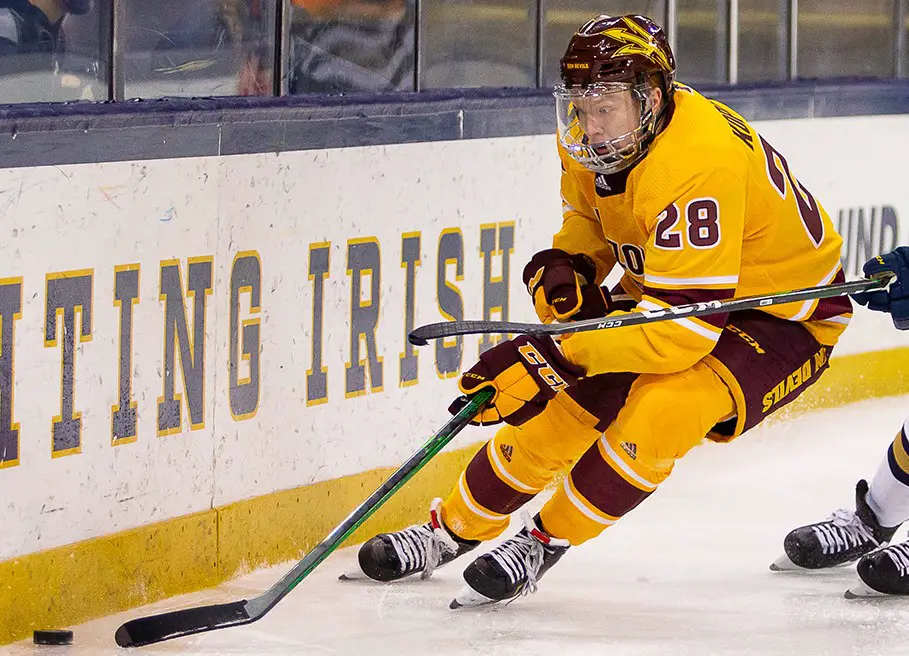
Each week during the season, we look at the big events and big games around Division I men’s college hockey in Tuesday Morning Quarterback.
Ed: Last weekend was the renewal of one of college hockey’s most storied rivalries, Jim, and that’s Minnesota and North Dakota.
Regular foes in the glory days of the WCHA, the two teams had not met at Engelstad Arena since October 2017, long enough that the only Golden Gopher to have played there was Grant Cruikshank, and that was when he was playing for Colorado College.
Minnesota’s 5-1 win on Friday night may have awakened a few people who had been sleeping on the somewhat inconsistent Gophers so far this season. Coach Bob Motzko was particularly complimentary of his defensemen Friday, while Minnesota outshot the Fighting Hawks 32-22, including 14-4 in the first period.
But it was quite the opposite story on Saturday in the 300th game between the two in a series begun in 1930. North Dakota tallied a goal in each period to open up a 3-0 lead, but the Gophers battled back to score twice in the third to make it close. Most impressive to me was that Brad Berry’s Hawks limited the visitors to just 13 shots on net.
Minnesota showed its potential on Friday and can take something good away from the weekend with that – and splits on the road are a good thing – but it seems as if the Gophers need to string a few games like that in a row if they want to establish themselves as an elite team.
Can North Dakota feel good about its response on Saturday and just shake off Friday night?
Jim: I’m totally okay with where North Dakota is right now. Are they the best team in the nation? Right now, no. But are they the team that anyone who plays them will know they’re in a battle? Heck yes.
I think the Fighting Hawks are trying to find consistency. They have swept Niagara, Denver and Miami – Denver being the most impressive of that trio. Every other team has been a split – Bemidji State, Quinnipiac, Minnesota Duluth and now Minnesota (plus that loss to Penn State in Nashville). I think almost any coach would take those splits.
The numbers say that North Dakota has played the third toughest schedule in the nation to date. So while I’ll watch carefully, I’m not worried about the Fighting Hawks. They’re one of the best teams in the nation in my mind.
If I have concern right now, it’s for the ECAC. Entering the weekend with a non-conference record a notch above .500, the ECAC added 11 losses to their non-conference record this weekend at a point of the season where that is concerning. When you consider the overall number of non-conference games that each conference plays, that’s about eight percent of the overall non-conference games played in the ECAC landing in the loss column in the same weekend. To me that’s a concern.
Another number I’ll throw out – approximately 81 percent of the nonconference games in men’s Division I hockey have already been played. Have we learned anything from that?
Ed: That’s enough games played to have a pretty good idea of how each league’s nonconference schedule will turn out. Without getting into the numbers inside the numbers that constitute the PairWise Rankings, your league’s overall out-of-conference record has a lot to do with how many teams you’ll get into the NCAA tournament with at-large bids.
I’m pretty happy if I’m the NCHC or Big Ten. Both conferences have won more than two-thirds of their non-league tilts so far, and that means it’s likely we’ll see three or four teams from each league – and dare I say maybe five from the NCHC?
But I’m a little concerned if I’m Hockey East, hovering just above .500 overall – though the league helped itself a bunch last weekend. I’m more than a bit worried if I’m the CCHA or ECAC Hockey – sitting quite a bit below .500 – and wondering if the conference will get more than two teams in. And if I’m Atlantic Hockey, I’m just hoping my teams run the table in the 20-plus non-league games left.
At Arizona State, every game is a nonconference game. Greg Powers has a talented team, but right now they’re sitting at 7-7 and really need to go better than 12-8 in their remaining 20 games to be in the NCAAs – but that’s not as difficult as it may seem. Looking at ASU’s schedule, if they split a few tough weekends and sweep the series they should sweep, the Sun Devils could sprint their way into the postseason. Do you see a good prognosis for Arizona State?
Jim: You bring up a solid point with Arizona State.
The Sun Devils qualified in 2019 and likely would’ve made the 2020 tournament had it been played. Currently, Arizona State, though, probably needs more than 12 wins to take a major jump and qualify for an at-large bid. My magic number for the Sun Devils is 22 wins, given that they won’t have any postseason tournament and have to bank all hopes in a 34-game schedule.
Right now, ASU has a 50/50 schedule left – 10 of the qualifying games are at home, 10 on the road (the two games against Lindenwood won’t count in the PairWise). In laymen’s terms, ASU need to sweep at home and go .500 on the road (our podcast co-host Derek Schooley’s mantra for how to win).
At this point in the season, I see a few teams that I feel are underrated. My top is Cornell, at 8-1-0. Though ranked ninth, the Big Red is tied for 20th in the PairWise. And going back to that famous ranking, maybe we shouldn’t even talk about that right now. But Cornell has to ascend quickly if this winning streak continues.
Ed: We broke that rule and talked a little PairWise on our Monday Weekend Review podcast along with Derek, though I still think it’s a little early to give it a lot of attention.
However, the non-league record of Hockey East has its top three teams hovering around college hockey’s Mendoza line from 13 to 16. A lot will change when everyone is mainly playing league games and teams start to cannibalize each others’ records.
While it’s hard to call teams in the top 10 of the USCHO men’s D-I ice hockey poll overlooked, two teams really impressing me right now are No. 4 Quinnipiac and No. 6 Western Michigan. The Bobcats picked up six first-place votes on Monday and are getting the job done with a stingy defense. Meanwhile, the Broncos are outscoring opponents by 3.9 to 2.5 and put up 13 goals at St. Lawrence over the weekend.
Quinnipiac undoubtedly has an easier route to the top of its league than does Western Michigan, but both have been pleasant surprises, and I expect them both in the NCAA mix come March.
Anyone else who fans need to watch out for that they may have missed?
Jim: I think two Hockey East teams feel legit to me – Massachusetts and UMass Lowell – and they will play this weekend in a massive two-game series. UMass has rebounded well from their opening weekend two-game loss to Minnesota State. UMass Lowell, maybe a tiny bit less tested, has lost just two games to Arizona State (on literally the opening night of the season) and Connecticut.
I also look outside of the typical teams we recognize and into Atlantic Hockey for a few clubs that will be there, possibly in that famous 16 vs. 1 game in the NCAA tournament. I think AIC is kind of expected and will be solid right to the end. But if any fans look past teams like Canisius, Army West Point and RIT, they’ll overlook some excellent teams.
Right now, using the PairWise as guidance, I don’t see a way that two Atlantic Hockey teams reach the tournament. But I see this quartet of AHA teams in one of the toughest battles for what is likely exactly one NCAA tournament spot.
It’s early for this – and everything else we’re talking when it comes to the NCAA tournament – but it’s very entertaining.


